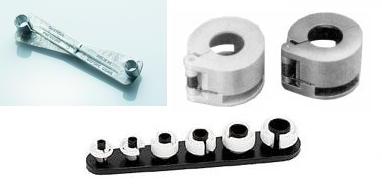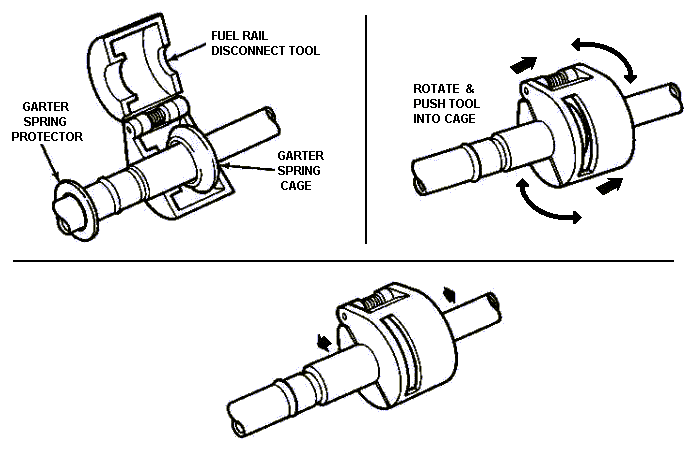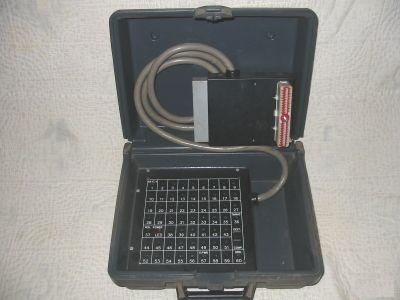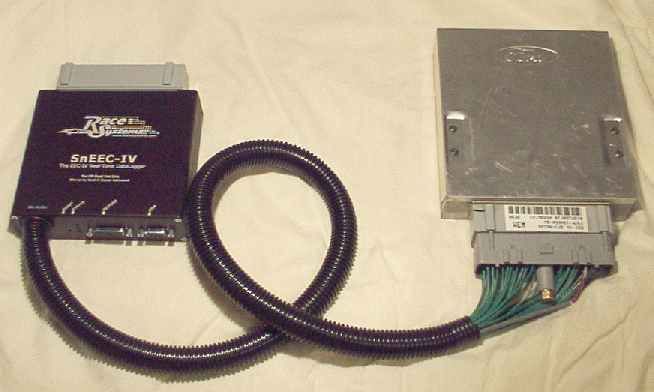EFI Tools
TFI Wrench

This wrench is the only way to remove and replace a TFI module. It is a special 7/32″ (5.5mm) socket with a very thin wall. The older design is smaller and used with a ¼ inch drive socket set. The design changed to this newer model with plastic handle. In some rare occasions the TFI bolts will have a T-20 head; you can get a top of the line ratcheted TFI tool that has a 7/32″ (5.5mm) end and a T-20 end. The TFI never needs to be torqued down with a socket set, so the simple plastic handle design is great and simple to use. To remove the TFI simply remove the two bolts, and slide the module downward. You MUST slide the TFI down before you pull it away from the distributor or it won't come off correctly.
Code Reader

1996 – up Ford vehicles have OBD II computers. You need an OBD II code reader to get the diagnostic trouble codes. Shown is a cheap $40 reader from Harbor Freight. Fits in the glove box, works on all OBD II vehicles, and clears the codes when finished. Simple to use, start vehicle – plug code reader into port under dash. Then the reader flashes the codes, and clears them from the memory when finished.
Fuel Pressure Test Gauge

To test the fuel pressure you’ll need this tool. You will need to screw it onto the schrader valve on the top of the fuel rail, it looks like a tire air valve stem. After attaching the fuel pressure tester, run the fuel pump for 10 seconds. Check that the pressure is within specs, and it doesn’t leakdown more than 5PSI within 60 seconds after pump shutdown.
Fuel Rail Disconnects

You must buy or borrow disconnect tools to disassemble the fuel rails. These are sold as disconnects for Ford fuel and AC fittings in most stores. There are two different styles to this tool. The cheaper version is shown in the first photo below. They are one-piece design. The more expensive version is a two-piece design, it springs open and closed. Both versions work very well. Here are a few different views of these fittings to ad your in there removal.

Here is a visual explanation on the removal of these fittings. I have found that you have to twist while pushing the disconnect tool into the cage. This helps ensure the spring spreads over the female fitting. Once the spring is spread over the female fitting, you have to pull the two ends apart. They are relatively durable fittings so don't be afraid to use some force to help the O-rings slide. Remember these are sealed to over 100PSI and they have been connected for how long?

Oxygen Sensor Socket
 This special socket helps remove and install Oxygen sensors in the exhaust system. It has a notch cut into the side for the pigtail connector, without it you’d have to cut off the connector to install it. Some exhaust systems mount the oxygen sensor in a location that is so easy to get at you can use a regular box end wrench to remove and install it. Other exhaust systems mount the oxygen sensor so hidden you’ll still struggle to remove it with this special tool. If you are having a custom exhaust system made or a sensor bung added to yours, think about sensor removal when choosing a location. You want it easy to get at, but not easy for road debris to catch it.
This special socket helps remove and install Oxygen sensors in the exhaust system. It has a notch cut into the side for the pigtail connector, without it you’d have to cut off the connector to install it. Some exhaust systems mount the oxygen sensor in a location that is so easy to get at you can use a regular box end wrench to remove and install it. Other exhaust systems mount the oxygen sensor so hidden you’ll still struggle to remove it with this special tool. If you are having a custom exhaust system made or a sensor bung added to yours, think about sensor removal when choosing a location. You want it easy to get at, but not easy for road debris to catch it.
T40 Upper Intake Socket
 This tool is made to help remove the upper intake from your vehicle. It is not needed for all Ford intakes. Some intakes have longer bolts that are easier to reach. But if you can only see 4 or 5 of the bolts holding the upper intake on the engine, you'll probably need one of these. The bolt that you can't see way down in the middle has a torx 40 head. It is possible to make a chain of 3/8 or 1/4 drive socket pieces to reach these bolts. But this page is about all the cool tools you don't have yet.
This tool is made to help remove the upper intake from your vehicle. It is not needed for all Ford intakes. Some intakes have longer bolts that are easier to reach. But if you can only see 4 or 5 of the bolts holding the upper intake on the engine, you'll probably need one of these. The bolt that you can't see way down in the middle has a torx 40 head. It is possible to make a chain of 3/8 or 1/4 drive socket pieces to reach these bolts. But this page is about all the cool tools you don't have yet.
Fuel Injector Cleaner
 This is a special tool that cleans fuel injectors, not something I recommend purchasing unless you will be renting it out to your friends. Cleaners that actually work well cost $150-$300, that could buy a set of new injectors! You can usually clean your injectors with compressed air and simple store bought aerosol cleaners.
This is a special tool that cleans fuel injectors, not something I recommend purchasing unless you will be renting it out to your friends. Cleaners that actually work well cost $150-$300, that could buy a set of new injectors! You can usually clean your injectors with compressed air and simple store bought aerosol cleaners.
TFI Tester
 This is a TFI tester. Don't expect a wonder tool for diagnosis of intermittent TFI problems. This tool will only show a completely failed module or a TFI that will start a vehicle. I haven't seen any TFI testers that will show a partly failed or intermediate problem. You connect a 9-volt battery and the TFI in question. Then you touch the yellow clip to the Stator pins. An LED will come on if it's a “good” TFI and no light if it's failed.
This is a TFI tester. Don't expect a wonder tool for diagnosis of intermittent TFI problems. This tool will only show a completely failed module or a TFI that will start a vehicle. I haven't seen any TFI testers that will show a partly failed or intermediate problem. You connect a 9-volt battery and the TFI in question. Then you touch the yellow clip to the Stator pins. An LED will come on if it's a “good” TFI and no light if it's failed.
A better test is to check the fuel pump relay when cranking the engine over. Not the 2 second run after the key is turned on, but while cranking the engine. If the fuel pump relay kicks on when cranking, the TFI & Stator are good.
60-pin Brake-Out-Box (BOB)
 If you can't find a problem or find yourself testing sensors every month this is the tool for you. This mounts between the computer and the harness. You bolt the 60-pin connector to the BOB and then mount the BOB to the computer. As you see in the picture there is a panel with 60 holes in it. You simply take the probes from you voltmeter and stick them in the holes that correspond to the sensor or wiring you are checking.
If you can't find a problem or find yourself testing sensors every month this is the tool for you. This mounts between the computer and the harness. You bolt the 60-pin connector to the BOB and then mount the BOB to the computer. As you see in the picture there is a panel with 60 holes in it. You simply take the probes from you voltmeter and stick them in the holes that correspond to the sensor or wiring you are checking.
SnEEC-IV

This is probably the coolest way to test and diagnosis problems on your Ford EEC-IV EFI vehicle. This is the ultimate Brake-Out-Box, in a class called data-loggers! You don't need a voltmeter, and all your friends will be jealous. Just like the BOB you mount the SnEEC between the 60-pin connector and the computer. That is where the similarities end. You have two options for checking EFI system status. There is a remote mounted switch that when you press the button it begins to record data. Say you have an intermediate problem you can't find. Drive the vehicle around, when the engine starts acting funny activate the switch, and the SnEEC records the event for further study. I know you already scrolled down to see the pictures, so you know that the SnEEC connects to a computer for reading. Two choices for reading the information. You can record the data; remove the SnEEC for diagnosis on the desktop computer. OR is you like cool toys you can leave a laptop computer installed in the vehicle. You can read all the sensors at once, engine RPM, vehicle speed, and even hook up a wide band oxygen sensor for testing and tuning of your EFI system. This SnEEC system can show recorded events on the laptop or it can read live data.


